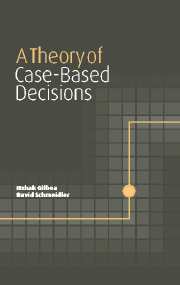5 - Planning
Published online by Cambridge University Press: 22 September 2009
Summary
Representation and evaluation of plans
Dissection, selection, and recombination
CBDT describes a decision as a single act that directly leads to an outcome. In many cases of interest, however, one may take an act not for its immediate outcome, but in order to be in a position to take another act following it. In other words, one may plan ahead. In this section we extend CBDT to a theory of case-based planning.
The formal model of CBDT distinguishes between problems, acts, and results. When planning is considered, the distinction between problems and results is blurred. The outcome of today's acts will determine the decision problem faced tomorrow. Thus the formal model of case-based planning will not distinguish between the two. Rather, we employ a unified concept of a “position”, which also can be viewed as a set of circumstances. A position might be a starting point for making a decision, that is, a problem, but also as the end result, namely, an outcome. We will therefore endow a position with (i) a set of available acts (in its capacity as a problem) and (ii) a utility valuation (when considered an outcome). Part of the planning process will be the decision, whether a certain position should be a completion of the plan, or a starting point for additional acts.
- Type
- Chapter
- Information
- A Theory of Case-Based Decisions , pp. 109 - 124Publisher: Cambridge University PressPrint publication year: 2001

